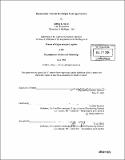Optimization tools for the freight brokerage industry
Author(s)
Silver, Jeffrey L. (Jeffrey Lee), 1962-
DownloadFull printable version (2.836Mb)
Other Contributors
Massachusetts Institute of Technology. Engineering Systems Division.
Advisor
Cynthia Barnhart.
Terms of use
Metadata
Show full item recordAbstract
The freight brokerage industry in North America was born of the deregulation of the trucking industry in 1982. In the two decades since, the industry has grown from nothing to $50 Billion in revenue. In the beginning, freight brokers used T-card systems to record, track, and bill orders. Technology advances over those two decades have driven many of the operational changes throughout the freight transportation industry as a whole, with shipment data visibility, asset utilization, and supply chain planning leading the way. The use of optimization tools in transportation and supply chain management has proliferated. Network analysis, inventory planning and deployment, fleet routing, and warehouse planning are important examples of areas in which these tools have had a major impact. However, the freight brokerage sub-industry itself has largely ignored the use of these tools. This research proposes pragmatic uses for optimization techniques in the freight brokerage industry. Three tools are proposed, with justifications for need, mathematical formulations, and exemplary situations and savings described. The three tools are: 1) optimal truckload freight tenders to multiple carriers, 2) optimal LTL consolidation, and 3) optimal matching of loads and trucks.
Description
Thesis (M. Eng. in Logistics)--Massachusetts Institute of Technology, Engineering Systems Division, 2003. Includes bibliographical references (leaf 46).
Date issued
2003Department
Massachusetts Institute of Technology. Engineering Systems DivisionPublisher
Massachusetts Institute of Technology
Keywords
Engineering Systems Division.